能を嗜む
Practice Noh
お能は観るもの……そう思っていませんか?能は観るだけでなく嗜むもの。豊臣秀吉をはじめ諸大名や剣術家、琳派を代表するアーティストや文豪達……歴史上の様々な人物達も観るだけではなく自ら謡い舞う事で能を嗜んできました。
能には和歌や漢詩など、この世界を美しく表現する言葉で溢れています。それを声に出して、または身体にのせて表現するお稽古は、自分の感性と向き合う時間です。能には茶道や禅の思想にも通じるところが多くありますので、日々の暮らしの中で様々な物事を発見するきっかけにもなります。あなたも能をやってみませんか?
While many people show their appreciation for Noh by watching performances, you can also take the leap to studying Noh performance. Many historical figures, from feudal lords and swordsmen to master painters and writers, picked up a fan to indulge in Noh.
Noh chant brims with beautiful words that describe the world—some from Japanese verse, some from Chinese poetry. Noh performers strive to use their aesthetic sensibility to fully express the meaning of the words through their voice and movements. Closely linked to Japanese tea ceremony and the philosophy of Zen Buddhism, the mindful practice of Noh can bring a sense of calm and enlightenment to your daily life. The doors are always open to those who are curious to try performing Noh for themselves.
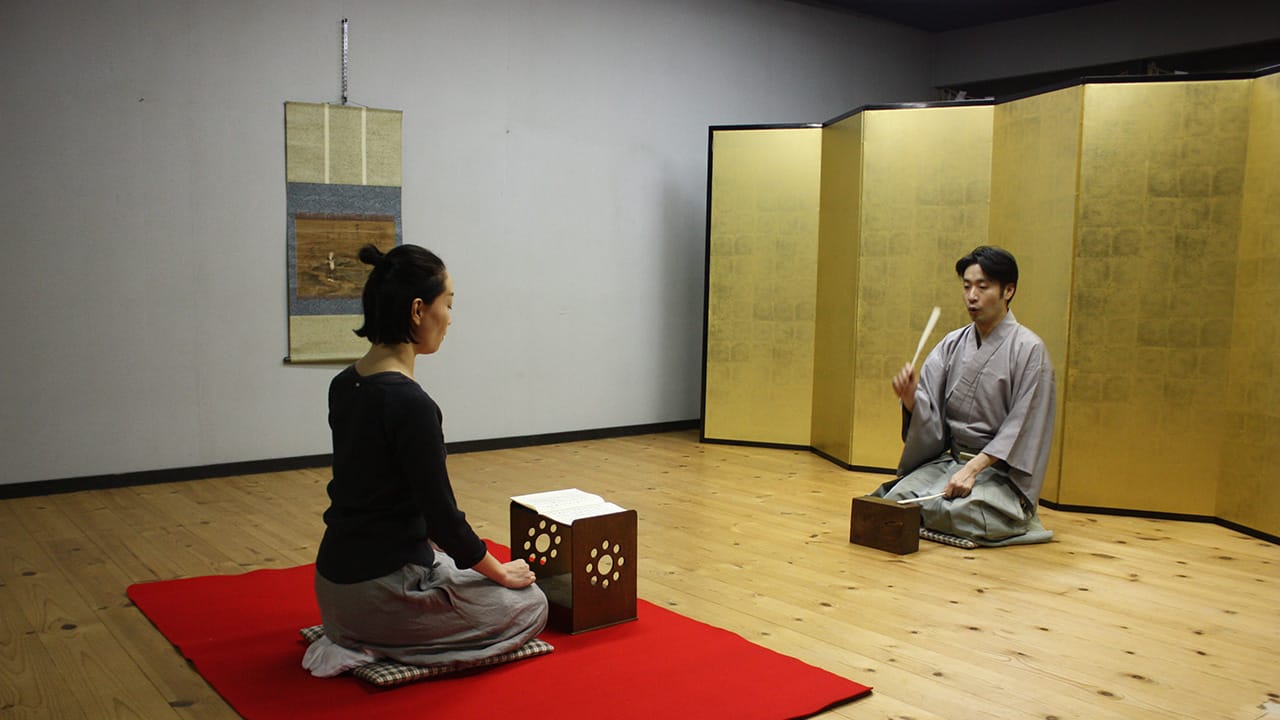
謡のお稽古 Utai (chant) lessons
能の台本とも言える謡本を使って謡います。謡本には「節(ふし)」と言われる記号があり、音の高さやメロディ・リズム・情感などが込められています。金剛流ではおよそ200曲の演目があり、季節や物語・登場人物によって謡い分けていきます。
You will chant while referring to utaibon, or japanese style books containing the texts of Noh plays. Symbols called fushi are added to the words to indicate pitch, melody, rhythm, and mood. The Kongo School covers about 200 plays, which feature different seasons, stories, and characters.
謡のお稽古は師匠と向き合って Chanting face to face with your shisho
最初は師匠の謡を聞いて、それを真似する「鸚鵡返し」という伝統的なお稽古から始まります。お能一曲を何回かに分けて少しずつ謡い進めて、最後の仕上げは一曲通して謡います。少し大変ですが謡い終わった時の爽快感はなんとも言えません。
You will begin with the traditional learning style of listening to your shisho (master actor) chant a short phrase and then repeating it. An entire play can be divided into several segments, and you will practice one segment at a time. Then you will chant the entire play from beginning to end, without pausing, to complete your practice of the play. That may be a bit challenging, but you cannot beat the exhilaration of chanting it through.
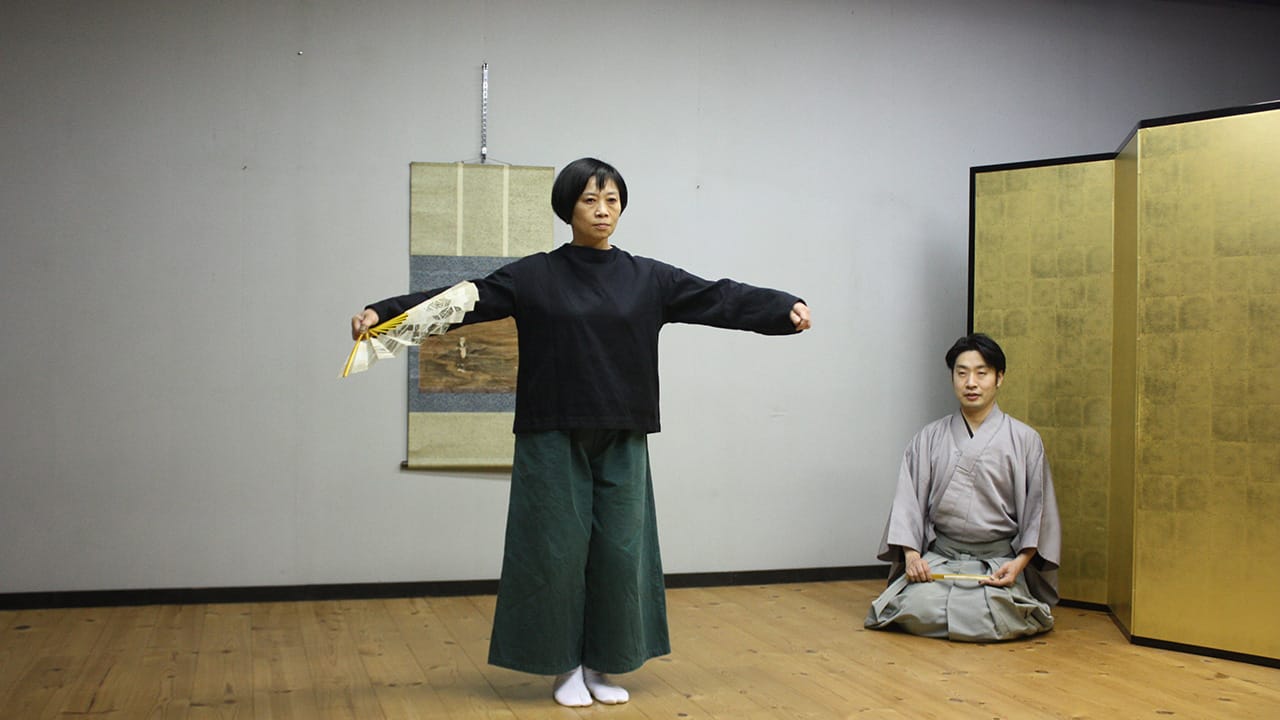
舞のお稽古 Mai (dance) lessons
舞は型と呼ばれる基本動作の組み合わせで舞います。最初は2分程度の舞を舞うのも難しいのですが、慣れてくると10分の舞や、お能一番を舞う事も出来る様になります。
Noh dance is a combination of basic movements called kata. You will start with shimai (dance excerpts) of about two minutes. As you practice, you will be able to dance shimai of 10 minutes and then even an entire play.
能舞台に立つ Performing on a Noh stage in recitals
お稽古の成果を舞台の上で披露する事が出来ます。プロの能楽師達と一緒に舞台に立つ事で、普段のお稽古では味わえない一期一会の瞬間を楽しむ事が出来ます。また、日頃のお稽古のモチベーションにも繋がります。
You will be given the opportunity to perform on stage in recitals to show the results of your hard work. Performing on stage with professional Noh actors gives you experience beyond the classroom, as well as motivation for your daily practice.
アイテム What you will need
-
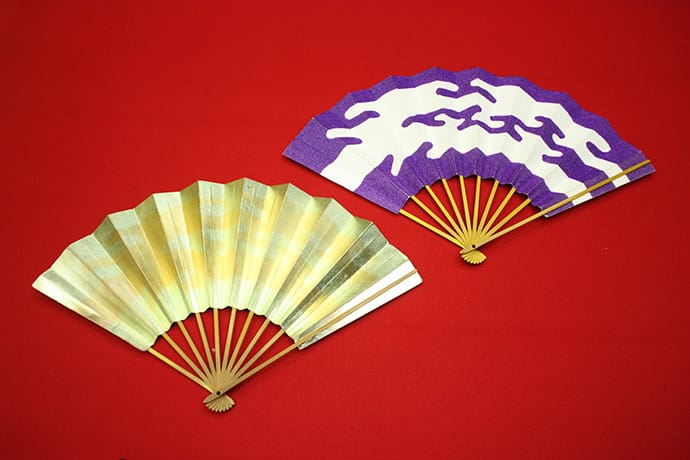
扇
能に使う扇は流儀によって違います。金剛流は骨(竹の部分)の形状が末広がりになっています。
Ōgi
The ōgi (folding fans) of the Kongo School have bamboo ribs that spread out from a pivot pin at the base . The design of the ōgi varies from school to school.
-
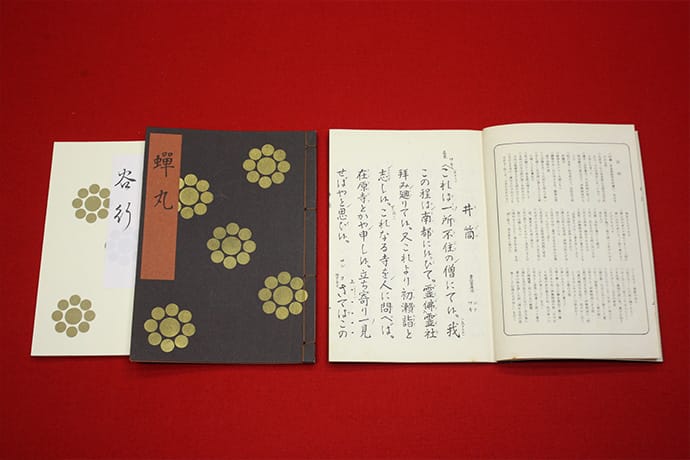
謡本
金剛流の流儀の紋・九曜紋のあしらわれた和綴の謡本です。中には変体仮名文字で書かれた謡本もあります。(お稽古の時には読み方も一緒にお教え致します)
Utaibon
Utaibon of the Kongo School have the crest of kuyō-mon on the cover. They are bound in the Japanese style, and some of them are written in old cursive Japanese. (If you prefer the cursive version, I will teach you how to read it during the lessons).
-
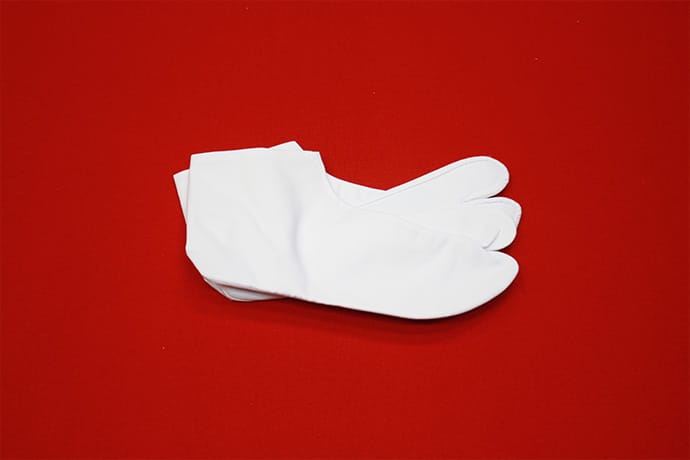
足袋
能のお稽古の時には白足袋を履きます。気持ちも引き締まってお稽古に集中出来ます。
Tabi
When taking a Noh lesson, you are required to wear a pair of white tabi socks. They help you get into the right frame of mind and center your concentration on the lesson.
お稽古場
Lesson locations and days of the week
-
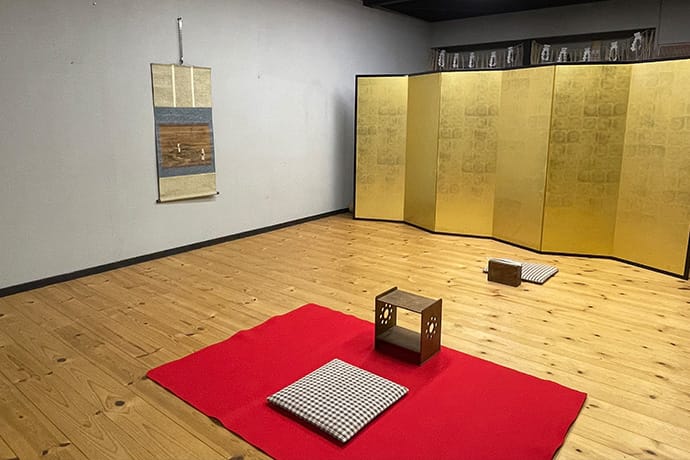
京都教室
火曜日・水曜日・金曜日(各2回/月)
景雲会敷舞台
〒606-0047
京都市左京区上高野薩田町111Kyoto
Tuesday, Wednesday, or Friday (twice a month)
Keiunkai Shikibutai
(111 Kamitakano Satsuta-cho, Sakyo-ku, Kyoto 606-0047) -
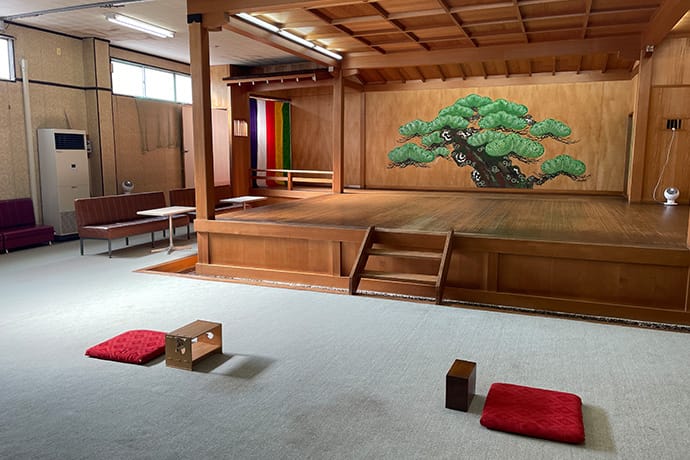
名古屋教室
土曜日(1回/月)
栄能楽堂
〒460-0008
愛知県名古屋市中区栄5丁目6-4 栄能楽ビル4FNagoya
Saturday (once a month)
Sakae Noh Theatre
(4F, Sakae Nogaku Bldg., 5-6-4 Sakae, Naka-Ku, Nagoya 460-0008) -
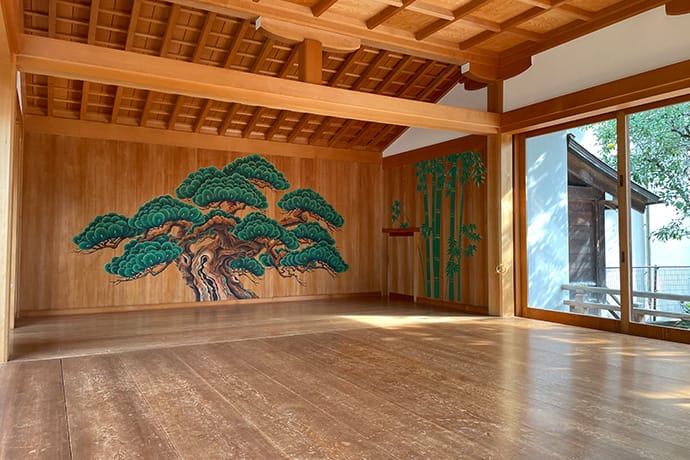
東京教室
土曜日又は日曜日(1回/月)
鳩森八幡神社 能楽殿
〒151-0051
東京都渋谷区千駄ヶ谷1丁目1-24Tokyo
Saturday or Sunday (once a month)
Nogaku-den, Hatomori Hachiman Shrine
(1-1-24 Sendagaya, Shibuya-ku, Tokyo 151-0051) -
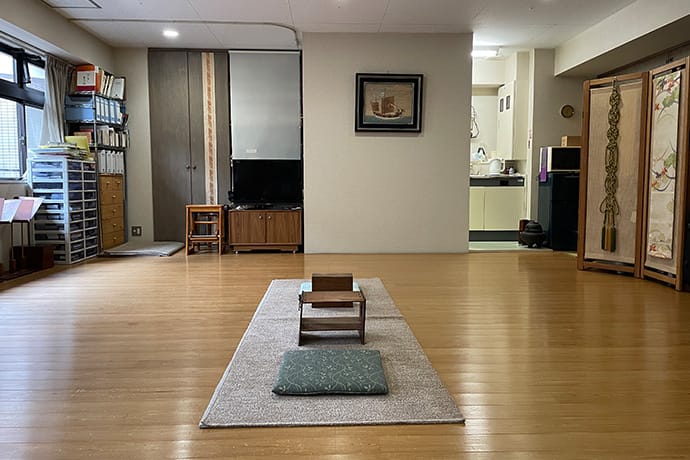
横浜教室
月曜日(1回/月)
久良岐会稽古場
神奈川県横浜市中区日ノ出町1-76-1
インペリアル横浜パークサイド2FYokohama
Monday (once a month)
Kuraki-kai Keiko-ba
(2F, Imperial Yokohama Parkside, 1-76-1 Hinode-cho, Naka-ku, Yokohama 231-0066)
入会金・お月謝 Enrollment and monthly tuition fees
- 入会金 Enrollment fee
- 15,000円 15,000 yen
-
- 京都 Kyoto
-
月2回 (twice a month)
謡 15,000円
謡+仕舞 20,000円- Utai or shimai
- 15,000 yen
- Utai and shimai
- 20,000 yen
-
- 名古屋 Nagoya
-
月1回 (once a month)
謡 10,000円
謡+仕舞 15,000円- Utai or shimai
- 10,000 yen
- Utai and shimai
- 20,000 yen
-
- 東京 Tokyo
-
月1回 (once a month)
謡 15,000円
謡+仕舞 20,000円- Utai or shimai
- 15,000 yen
- Utai and shimai
- 20,000 yen
-
- 横浜 Yokohama
-
月1回 (once a month)
謡 15,000円
謡+仕舞 20,000円- Utai or shimai
- 15,000 yen
- Utai and shimai
- 20,000 yen
Q&A Frequently Asked Questions
-
- お能のお稽古は全く初めてなのですが大丈夫ですか? I've never taken Noh lessons. I'm just curious about Noh, and I'm not sure how far I want to take this hobby. Would it still be okay to try lessons?
- もちろんです。お稽古に興味を持たれたきっかけや、モチベーションは人それぞれなので、最初にお話し合いをさせて頂き、お稽古の方針を決めていきましょう。 Sure. Everyone has their own reason or motivation for becoming interested in practicing Noh. Let me hear yours first and see what I can do for you.
-
- お稽古を始めるのに年齢制限はありますか? Is there a recommended age to start taking lessons?
- 子供がお稽古事を始めるのは六歳になる年の六月六日が良いとされます。お能のお稽古をなさる方は、小さなお子さんからご高齢の方まで幅広い年齢層があります。 People of all ages, from small children to senior citizens, enjoy practicing Noh. By the way, in Japan, June 6 of the year in which one turns six is said to be the best day to start taking lessons of any kind.
-
- お稽古に必要なものはどうやって揃えたらいいですか? Where can I get the required materials and clothing for the lessons?
-
まずは謡本・扇・白足袋が必要になります。
謡本は東京にある檜書店(ひのきしょてん)で購入できます。オンラインストアはこちら
扇は京都の東本願寺近くにある本家十松屋さん(京都市下京区上珠数屋町通東洞院東入ル TEL 075-361-0074075-361-0074)で購入できます。昔ながらのお店なので一度お電話されてから行かれることをお勧めします。
※京都以外の教室では私が代理で購入する事も可能です。白足袋は色々なものがありますが、株式会社皆中(かいちゅう)のノーアイロン足袋は比較的安価で手入れも簡単ですので普段使いにお勧めです。オンラインストアはこちら
First, you will need utaibon, an ōgi, and a pair of white tabi.
Utaibon are available from Hinoki Shoten, a publisher and bookstore in Tokyo with an online store. The online store is in Japanese and ships within Japan. If you need any assistance in ordering utaibon, please let me know.
Ōgi used by the Kongo School are supplied by Honke Tomatsuya, an ōgi store near Higashi Honganji Temple in Kyoto. You can purchase one through me.
White tabi are available from many brands. My recommendation is Kaichu's wrinkle-free tabi, which are low-maintenance and relatively inexpensive.
-
- 発表会などはありますか? Will I have the opportunity to perform in recitals?
- 私の教室では通常年に二回、新年会と夏の会を開催しています。日々のお稽古の目標になるとモチベーションが上がります。発表会は別途経費がかかりますが、参加は自由です。 Yes, you will, twice a year. I hold a New Year's Recital and a Summer Recital for my students where those who wish to perform may do so for a separate fee. Recitals are a great motivator for daily practice.
-
- 正座が苦手なのですが椅子でのお稽古は可能ですか? I can't sit on my heels very well. Can I use a chair during the utai lessons?
-
ご高齢の方や、足の具合が悪い方には椅子でのお稽古をお勧めします。まずはご相談ください。
I recommend students use a chair if they are older or have some trouble with their legs.
If you have trouble sitting on your heels, please let me know.
-
- 娘の結婚式で高砂の謡を謡いたいのですが、期間限定でのお稽古は可能ですか?
- この度はおめでとうございます!もちろん大歓迎です。謡い方だけでなく、着物の着方や謡う時の所作などもご指導いたします。
-
- プロの能楽師になれますか? Can I become a professional Noh actor if I want to?
- プロの能楽師の全員が世襲の家の子という事ではありませんので、なれる可能性はあります。長い修行期間と日々の鍛錬が必要なので、その覚悟があるならばお力添えいたします。 Not all professional Noh actors are born into families of the profession. It is possible for you to become one, but it requires long-term training and daily hard work. If you are fully determined to pursue this career, I will be happy to help you.
公演について・お稽古について・その他
各種お問い合わせはこちら
For inquiries about performances, lessons, or other matters,
click the button below.